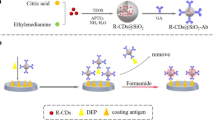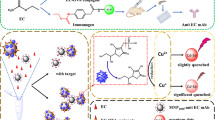Abstract
Quantum dots (QDs) are preferred as high-resolution biological fluorescent probes because of their inherent optical properties compared with organic dyes. This intrinsic property of QDs has been made use of for sensitive detection of methylparathion (MP) at picogramme levels. The specificity of the assay was attributed to highly specific immunological reactions. Competitive binding between free MP and CdTe QD bioconjugated MP (MP-BSA-CdTe) with immobilized anti-MP IgY antibodies was monitored in a flow-injection system. The fluorescence intensity of MP-BSA-CdTe bioconjugate eluted from the column was found to be directly proportional to the free MP concentration. Hence, it was possible to detect MP in a linear range of 0.1–1 ng mL−1 with a regression coefficient R 2 = 0.9905. In this investigation, IgY proved advantageous over IgG class immunoglobulins in terms of yield, stability, cost effectiveness, and enhancement of assay sensitivity. The photo-absorption spectrum of bioconjugated CdTe QD (λ max = 310 nm) confirmed nano-biomolecular interactions. The results suggest the potential application of bioconjugation and nano-biomolecular interactions of QDs for biological labeling and target analyte detection with high sensitivity.





Similar content being viewed by others
References
Ramadurai D, Geerpuram D, Alexson D, Dutta M, Kotov NA, Tang Z, Stroscio MA (2006) Superlattices Microstruct 40:38–44
Pathak S, Davidson MC, Silva GA (2007) Nano Lett 7:1839–1845
Bao H, Gong Y, Li Z, Gao M (2004) Struct Chem Mater 16:3853–3859
Bruchez MJ, Moronne M, Weiss GPS, Alivisatos AP (1998) Science 281:2013–2016
Weng JF, Song X, Li L, Qian H, Chen K, Xu X, Cao C, Ren J (2006) Talanta 70:397–402
Csaki A, Maubach G, Born D, Reichart J, Fritzsche W (2002) Single Mol 3:275–280
Ho YP, Kung MC, Yang S, Wang TH (2005) Nano Lett 5:1693–1697
Bakalova R, Ohba H, Zhelev Z, Nagase T, Jose R, Ishikava M, Baba Y (2004) Nano Lett 4:1567–1573
Yen HC, Ho YP, Shin LM, Wang TH (2006) Nuclei Acid Res 34:1–8
Mamedova NN, Kotov NA, Rogach AL, Studer J (2001) Nano Lett 1:281–286
Ma Q, Su XG, Wang XY, Wan Y, Wang CL, Yang B, Jin QH (2005) Talanta 67:1029–1034
Vinayaka AC, Basheer S, Thakur MS (2009) Biosens Bioelectron 24:1615–1620
Fox JE, Gulledge J, Engelhaupt E, Burow ME, Mclachlan JA (2007) PNAS 104:10282–10287
Rastogi SK, Singh VK, Kesavachandran C, Jyoti, Siddiqui MKJ, Mathur N, Bharti RS (2008) Ind J Occup Environ Med 12:29–32
Oliva J, Barba A, Vela N, Melendreras F, Navarro SJ (2000) J Chromatogr 882:213–220
Pappas CJ, Kyriakidis NB, Athanasopoulos PE (1998) J AOAC 82:359–363
Chapalamadugu S, Chaudhry GR (1992) Crit Rev Biotechnol 12:357–389
Thakur MS, Karanth NG (2003) In: Malhotra BD, Turner APF (eds) Research and development on biosensors for food analysis in India, Advances in Biosensors. Elsevier, Amsterdam
Chouhan RS, Babu KV, Kumar MA, Neeta NS, Thakur MS, Rani BEA, Pasha A, Karanth NGK, Karanth NG (2006) Biosens Bioelectron 21:1264–1271
Akita EM, Nakai S (1993) J Immunol Methods 160:207–214
Hermanson GT, Mallia AK, Smith PK (1992) Immobilized affinity ligand techniques. Academic Press, San Diego
Li M, Ge Y, Chen Q, Xu S, Wang N, Zhang X (2007) Talanta 72:89–94
Wang S, Mamedova N, Kotov NA, Chen W, Studer J (2002) Nano Lett 2:817–822
Akita EM, Li-Chan ECY (1998) J Dairy Sci 81:54–63
Acknowledgement
The authors thank the Director, CFTRI, Mysore, for providing facilities. Mr R.S. Chouhan and Mr A.C. Vinayaka are grateful to the Council of Scientific and Industrial Research (CSIR) for Senior Research Fellowships. The Department of Biotechnology, Government of India, and the Swiss Development Cooperation, Switzerland, are gratefully acknowledged for providing financial support under the Indo-Swiss Biotechnology collaborative project (ISCB). Dr K.R. Thampi, Dr Sridevi A. Singh, Dr P. Srinivas, Dr K. N. Gurudutt, and Dr Sanjukta Patra, IIT, Gowahati are acknowledged for their kind help and support.
Author information
Authors and Affiliations
Corresponding author
Supplementary electronic material
Below is the link to the electronic supplementary material.
ESM 1
(PDF 608 kb)
Rights and permissions
About this article
Cite this article
Chouhan, R.S., Vinayaka, A.C. & Thakur, M.S. Thiol-stabilized luminescent CdTe quantum dot as biological fluorescent probe for sensitive detection of methyl parathion by a fluoroimmunochromatographic technique. Anal Bioanal Chem 397, 1467–1475 (2010). https://doi.org/10.1007/s00216-009-3433-1
Received:
Revised:
Accepted:
Published:
Issue Date:
DOI: https://doi.org/10.1007/s00216-009-3433-1




